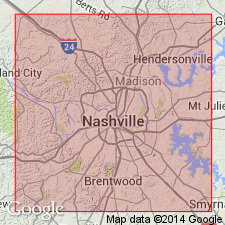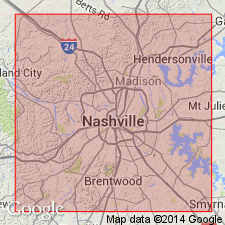
- Usage in publication:
-
- Ward limestone
- Modifications:
-
- Named
- Dominant lithology:
-
- Limestone
- AAPG geologic province:
-
- Cincinnati arch
Summary:
Name Ward limestone introduced here for dark-blue coarsely crystalline limestone exposed in Mrs. Ward's quarry. Cross stratification shown at a few places. Thickness 25 to 28 ft. Underlies False Dove limestone or CYRTODINTA bed; overlies Dove limestone. Contains few fossils. [Beds were formerly included in Bigby limestone, but R.S. Bassler (1932: TN Div. Geol. Bull. 38) included these beds and the underlying Dove limestone in Cannon limestone.]
Source: GNU records (USGS DDS-6; Reston GNULEX).

- Usage in publication:
-
- Ward limestone member
- Modifications:
-
- Revised
- AAPG geologic province:
-
- Cincinnati arch
Summary:
Pg. 24, 27-29, geol. map. Ward limestone member of Cannon limestone. Averages 25 feet-thick in Nashville area; consists of massively bedded, very coarse-grained, gray to bluish-gray limestone, locally extensively cross-bedded or irregularly bedded. Overlain and underlain by units termed upper dove-colored member and lower dove-colored member. Age is Middle Ordovician.
Source: US geologic names lexicon (USGS Bull. 1200, p. 4125).
For more information, please contact Nancy Stamm, Geologic Names Committee Secretary.
Asterisk (*) indicates published by U.S. Geological Survey authors.
"No current usage" (†) implies that a name has been abandoned or has fallen into disuse. Former usage and, if known, replacement name given in parentheses ( ).
Slash (/) indicates name conflicts with nomenclatural guidelines (CSN, 1933; ACSN, 1961, 1970; NACSN, 1983, 2005, 2021). May be explained within brackets ([ ]).

